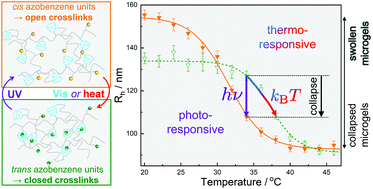Photo- and thermo-responsive microgels with supramolecular crosslinks for wavelength tunability of the volume phase transition temperature†
Abstract
Functional microgels have powerful applications, especially due to their quick responsiveness to different external stimuli such as temperature, pH, ionic strength, solvent composition and light. Here, we describe the synthesis of novel dual-responsive poly(N-isopropylacrylamide) (PNIPAM) microgels and demonstrate that, in addition to temperature, light changes their properties. The crosslinks inside the microgels were achieved by the host–guest interactions between the trans azobenzene (transAzo) and β-cyclodextrin (βCD) units. transAzo can be photoisomerized to cisAzo which exhibits significant lower binding affinity to βCD. As a consequence, the crosslink density, and thus several microgel properties, can be controlled by light irradiation. Surprisingly, this irradiation with light can significantly change the volume phase transition temperature (VPTT) by several degrees centigrade, presumably due to the fact that the polar βCD shields the transAzo bound to it, whereas the unbound cisAzo is rather apolar. As a result, continuous irradiation with specific wavelengths until reaching the respective photostationary state allows for a full control over the VPTT within the physiologically relevant range between 32 °C and 38 °C.



 Please wait while we load your content...
Please wait while we load your content...